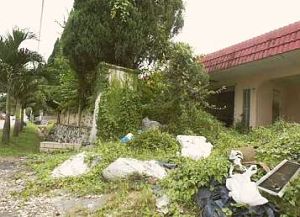By Frederick Fernandez
Eyesores that threaten the neighbourhood
APART from being “eyesores,” abandoned houses and buildings pose a danger
to residents as such places have proven to be a major contributor to crime.
Data in the Klang Valley show that vacant houses and shoplots were used
by bad hats to commit rape, sodomy and, in the worst cases, even murder.
Abandoned buildings are often a haven for drug addicts who would sniff or
smoke drugs there.
Often, desperate to buy drugs, these same people would be involved in
snatch thefts, house break-ins and petty thefts.
 |
|
Source of trouble: An abandoned house in Section 17,
Petaling Jaya, that might be used by thieves and drug addicts.
|
Some thieves even bore holes through the walls of abandoned houses to
loot valuables and goods from the neighbouring houses.
Abandoned homes are also a popular choice for irresponsible quarters to
dump rubbish and other waste – a despicable act often carried out by those
living outside the neighbourhood.
Abandoned houses were the main cause of the surge in dengue cases in
USJ11, Subang Jaya, last year.
In some abandoned houses, snakes take refuge in the compounds that are
overgrown with lallang, causing the neighbours to live in fear.
All these problems point to a clear fact: abandoned buildings are the
source of crime, social ills and killer diseases and we cannot continue to
close our eyes.
Logically, nobody would want to live next door to an abandoned house as
they know too well what would be coming their way; fear, frustration,
anxiety and anger.
Therefore, it is high time the government opened its eyes and see the
many problems arising from abandoned buildings or homes.
Under the Local Government Act 1976, the Town and Country Planning Act
1976 and the National Land Code, the authorities are empowered to enter and
take action in a vacant premises for safety and security reasons.
If the abandoned building becomes a nuisance in the neighbourhood, it
should be demolished.
If the owners of the premises are not traceable, residents' associations
(RA) and Rukun Tetangga (RT) units could organise gotong-royong
sessions to clean up such places and, if necessary, seek funding to fence up
the abandoned buildings while the authorities initiate a permanent solution
to the problem.
Better still, if there no one comes forward to claim ownership of
abandoned homes, the law should allow the government to refurbish and offer
them to the homeless or charity organisations.
Perhaps when this becomes a reality, we can all sleep well without
worrying whether the house next door is abandoned.